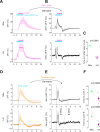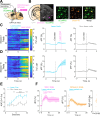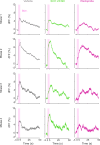Stimulation of VTA dopamine inputs to LH upregulates orexin neuronal activity in a DRD2-dependent manner
- PMID: 38567902
- PMCID: PMC10990487
- DOI: 10.7554/eLife.90158
Stimulation of VTA dopamine inputs to LH upregulates orexin neuronal activity in a DRD2-dependent manner
Abstract
Dopamine and orexins (hypocretins) play important roles in regulating reward-seeking behaviors. It is known that hypothalamic orexinergic neurons project to dopamine neurons in the ventral tegmental area (VTA), where they can stimulate dopaminergic neuronal activity. Although there are reciprocal connections between dopaminergic and orexinergic systems, whether and how dopamine regulates the activity of orexin neurons is currently not known. Here we implemented an opto-Pavlovian task in which mice learn to associate a sensory cue with optogenetic dopamine neuron stimulation to investigate the relationship between dopamine release and orexin neuron activity in the lateral hypothalamus (LH). We found that dopamine release can be evoked in LH upon optogenetic stimulation of VTA dopamine neurons and is also naturally evoked by cue presentation after opto-Pavlovian learning. Furthermore, orexin neuron activity could also be upregulated by local stimulation of dopaminergic terminals in the LH in a way that is partially dependent on dopamine D2 receptors (DRD2). Our results reveal previously unknown orexinergic coding of reward expectation and unveil an orexin-regulatory axis mediated by local dopamine inputs in the LH.
Keywords: D2 receptors; Pavlovian conditioning; dopamine; hypothalamys; mouse; neuroscience; nucleus accumbens; optogenetics; orexin.
© 2023, Harada et al.
Conflict of interest statement
MH, LC, MW, DB, TP No competing interests declared
Figures










Update of
- doi: 10.1101/2023.06.13.544720
- doi: 10.7554/eLife.90158.1
- doi: 10.7554/eLife.90158.2
References
-
- Bracey EF, Grujic N, Peleg-Raibstein D, Burdakov D. Coding of Reward Uncertainty and Probability by Orexin Neurons. bioRxiv. 2022 doi: 10.1101/2022.04.13.488195. - DOI
MeSH terms
Substances
Grants and funding
LinkOut - more resources
Full Text Sources

